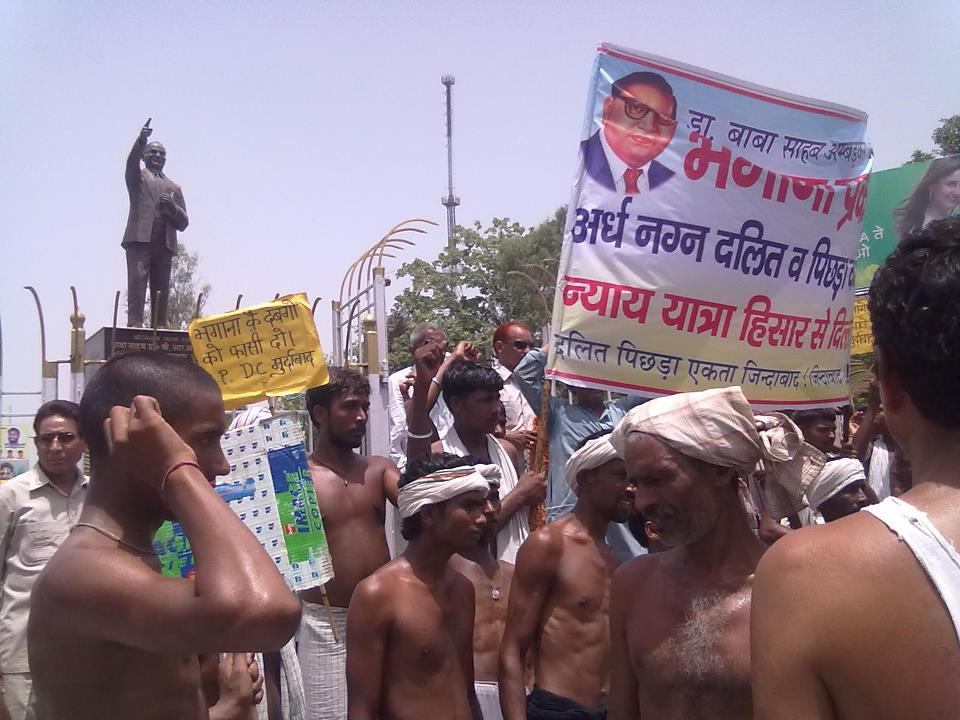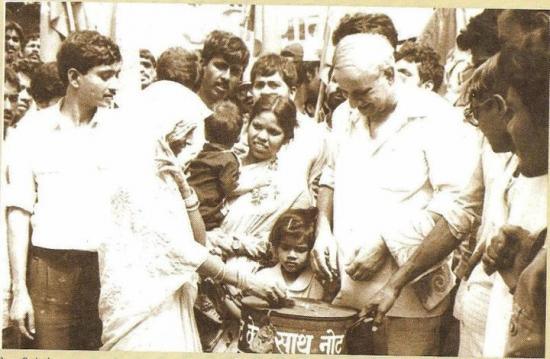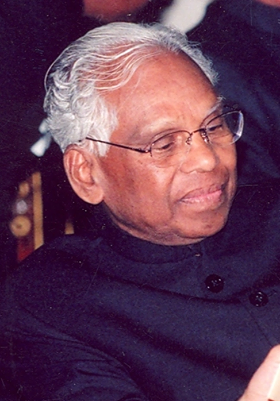Ratnesh Katulkar
Continued from here.
 It was during the Mauryan period, particularly at the time of Asoka, that India reached its zenith. There was an advanced stage of development in the field of architecture (which is visible in the remains of the Asokan inscriptions), science and technology, literature, administration and above all the emergence of the welfare state which is still absent in many part of the world in the modern times. Still none of the historians finds this period as the golden era of India; rather most of them even do not hesitate in declaring the Gupta period (300 AD) as a golden age. The reason they give for this declaration is the growth and development in the fields of arts, science and literature. The argument, however, has little truth, as there had already been much development in these sectors during the Mauryan regime. Moreover, how one can ignore that in the light of these developments in Gupta period there was emergence and establishment of the downfall of society? The evil customs like caste, untouchability, patriarchy in its worst form, like enforced widowhood, sati system and the rise of feudalism were the striking characteristics of this period.1 As rightly marked by Kosambi, ‘During Gupta period, the civilising and socialising work of the Buddha and of Asoka was never continued. The tightening of caste boundary begins.’2
It was during the Mauryan period, particularly at the time of Asoka, that India reached its zenith. There was an advanced stage of development in the field of architecture (which is visible in the remains of the Asokan inscriptions), science and technology, literature, administration and above all the emergence of the welfare state which is still absent in many part of the world in the modern times. Still none of the historians finds this period as the golden era of India; rather most of them even do not hesitate in declaring the Gupta period (300 AD) as a golden age. The reason they give for this declaration is the growth and development in the fields of arts, science and literature. The argument, however, has little truth, as there had already been much development in these sectors during the Mauryan regime. Moreover, how one can ignore that in the light of these developments in Gupta period there was emergence and establishment of the downfall of society? The evil customs like caste, untouchability, patriarchy in its worst form, like enforced widowhood, sati system and the rise of feudalism were the striking characteristics of this period.1 As rightly marked by Kosambi, ‘During Gupta period, the civilising and socialising work of the Buddha and of Asoka was never continued. The tightening of caste boundary begins.’2
In the history of ancient India and of Buddhism, the decline of Buddhism is of remarkable importance. This issue should be a striking subject of study, for when Buddhism continued to survive in other parts of world why was it extinguished from the land of its birth? The reasons for the decline of Buddhism mentioned by historians are weird. R.C. Majumdar, who tried to present Asoka’s Dhamma as non-Buddhist old tradition strangely blamed his appointment of Dhamma Mahamatra and policy of non-violence as the factors responsible for the decline of Buddhism.3 So there is a chunk of historians who think that the large donations to Sangha led to economic decline of the Mauryan Empire. But none of them tried to accept the Buddhist sources as evidence. Dr Ambedkar dealt with this issue seriously. Using the reference of Haraprasad Shastri, he says:
The decline of Buddhism is the result of Brahmanic reaction, which lost all their special privilege as Asoka prohibited all animal sacrifices which constituted the essence of Brahmanic religion. The Brahmins had not only lost state patronage but they lost their occupation which manly consisted in performing sacrifices for a fee which often times was very substantial and which constituted their chief source of living. The Brahmins therefore lived as suppressed and depressed classes for nearly 140 years during which the Maurya Empire lasted. A rebellion against the Buddhist state was the only way escape left to the suffering Brahmins and there is special reason why Pushyamitra should raise banner of revolt against the Mauryas.4
The nature of communal violence sparked at that time by Sunga was such that he made a proclamation of setting a price of 100 gold pieces on the head of every monk. The condition of the Buddhists under the imperial sway of the Sunga, orthodox and bigoted, can be more easily imagined than described. From Chinese authorities it is known that many Buddhists still do not pronounce the name of Pushymaitra without a curse5. This counter revolution resulted not only in the loss of life of Buddhist intellectuals and leaders but a large amount of Buddhist scriptures and monuments were brutally destroyed. As recorded by Buddhist historian Taranath:
The Brahmana king Pushyamitra, along with other tirthakas, started war and they burned down numerous monasteries form Madhyadesa to Jalandhar. They also killed a number of vastly learned monks. But most of them fled to other countries. As a result, within five years the Doctrine was extinct in the north.6
Leading Buddhist scholar Gail Omvedt also provides details in this regard. She says, ‘Buddhist sources point more specifically to a great deal of violence in the millennial-long conflict of Buddhism and Brahmanism. Huan Tsang, for example, gave many stories of violence, including the well-known story of the Shaivaite king Shahsanka, cutting down the Bodhi tree, breaking memorial stones and attempting to destroy other images. He also mentions a great monumental cave-temple construction in a mountainous area in Vidarbha, said to have been done by the Satavahana king under the instigation of Nagarjuna, that was totally destroyed….The second hostility appears to be that of Mihirkula (the fiercely anti-Buddhist king who raided north India in the 6th century).7 The Indian historians also ignored the detailed history of another Buddhist legend, Kanishka. His murder by his own army while he was sleeping was in some way similar to that of the killing of the last Mauryan successor Brihadrath but this incident was ignored by them as a normal incident.
There is also a sense of unanimity among the historians in the matter of the decline of Buddhism from India. A.L. Basham, for instance, opined that the persecution was not the main cause of decline of Buddhism8, so is the opinion of Nehru, who was not able to find any struggle between Buddhism and Brahmanism. He viewed that there is no feud between Buddhism and Hinduism. He also viewed that Buddhism borrowed from Vedanta and Upanishads.9 Romila Thapar went a step ahead by saying, ‘Buddhist sources claim that he (Sunga) persecuted the Buddhists and destroyed their monasteries and places of worship, especially those which had been built by Ashoka. This was clearly an exaggeration, since archaeological evidence reveals that Buddhist monuments at this time were being renewed.’10
This opinion is similar to her biased opinions mentioned in the previous part of this essay. There has not been a single evidence to prove that Sunga was not responsible for the destruction of as many as 84,000 stupas and that he carried out communal violence against the Buddhists. However, the stupas for instance, the one at Sanchi which was said to be elaborated during this regime was in no way carried out by the Sunga. It was rather rebuilt by the native Buddhist citizens. The reason of rebuilding may be a reaction against Pushyamitra’s atrocities. This fact could be referred by looking into the archaeological remains at Sanchi, where one can find the names of the Buddhist layperson (donors) carved in the great monument but not the name of Sunga as claimed by Thapar.
When Buddhism was extinguished from India, the ideological remains were not washed out. Many modern Buddhist scholars tried to present this idea. The emergence of Kabir, Raidas and many other revolutionary thinkers in medieval India were such examples, who directly carried on the message of the Buddha without using any external formalities. But the Indian thinkers do not spare even them. Instead of accepting the Buddhist impact on Kabir, they, for instance Ramvilas Sharma, brought out a strange connection of him (Kabir) with Vedanta and Upanishads.
These saints were not inspired from the Buddhist philosophy, but they were inspired by the Vedanta. From Kashmir to Kanyakumari there was no saint who had not been inspired by Vedanta.11
But if one actually analyses the teachings of Kabir no evidence can be found to show any linkage with or any form of influence, with respect to Vedanta or Upanishads. First, Kabir and all his contemporary saints were illiterates and had no knowledge of Sanskrit – a language in which all these brahmanic scriptures were composed. Therefore there is no question of their reading, understanding and getting influenced by this Sanskrit literature. Second, they did not remain silent on the Vedic literature, in fact they were not hesitant in criticizing these texts. Kabir says:
Leave aside divine Veda and other texts; they all are your creation
These texts are no way true but were created to make confusion12
Further, those who are trying to pose Kabir and his other contemporary Dalit thinkers as the pupils of a Brahmin teacher Ramananda are using the most ridiculous argument and can be refuted on the simple ground that the teachings and practice of Ramananda on one side and Kabir and his Dalit contemporaries on the other side are not only fundamentally different but contrary to each other13. There is also no evidence to show Ramananda as a teacher of these thinkers.14
Kabir in fact seems to have been very much influenced by Buddhism. His verses in the contemporary mainstream language of downtrodden were simple translations of the Buddha’s teachings. For instance, the Buddha’s last message Atta Deepo Bhav (Thy enlighten thyself) is delivered by Kabir in the following way:
As oil dwells inside oilseed, ignition stone carries in it fire
So does your master reside in you, if one try could acquire15
The historians even tried to ignore the revival of Buddhism in modern India, which emerged especially with the historical conversion of Dr Ambedkar on 14th October 1956 where about 3,00,000 of his followers adopted Buddhism.16 Romila Thapar17 ignores this issue by putting this fact only in a footnote of her chapter, where she even ignores the name of Dr Ambedkar. Ramvilas Sharma was even shrewder as he says that Ambedkar’s conversion to Buddhism was not spiritual but a political act as he wanted to claim special provision for Dalit communities so therefore to bind illiterate people in a camp he chose Buddhism.18 This was again not only illogical but is also a factually wrong comment. First, if there was a political motive behind conversion Dr Ambedkar would have chose Christianity19 instead as by then he would be in a position to demand and secure special rights for himself as well as for Dalits – as the British were in power at the time of Ambedkar’s struggle. Second, when in 1956 he practically embraced Buddhism, it was much before that that he had successfully enacted the special privilege and rights for the Dalits in the constitution of India.
Conclusion
It is a well known fact that much of ancient Indian history was not at all a history but mythology. The writing of history of India, in a proper sense began with the westerners. Historians and authors such as Vincent A Smith, Muir, Max Muller, Winternitz, William Jackson, Rhys David, Horner and many other intellectuals were credited with producing the history of India. Indeed their work was an eye opener. However the mainstream Indian historians expressed reservations against them and disapproved of many of their works by referring to them as a colonial perspective. But when these Indian historians themselves were involved in the task of writing history, their own caste-class bias came out in the open; this is reflected in many issues, particularly on the issue of Buddhism which is discussed in this two-part essay. For the readers of the marginalized sections, particularly Buddhists and Dalits, these historians’ expression of history is much more colonial than the so-called colonial outlook of western authors.
~
Notes
1. National Institute of Biomedical Genomics (NIBMG) Kalyani in its study based on analysis of DNA samples of 367 unrelated Indians belonging to 20 population groups concluded that caste and endogamy was developed in India during Gupta period, see TOI dated 5 February 2016, ‘ 70 generations ago, caste stopped people inter-mixing.’
2. Kosambi, The Culture and Civilization of Ancient India in Historical Outline p. 173
3. RC Majumdar, An Advanced History of India p. 103-104
4. Dr Ambedkar ‘Revolution and Counter Revolution in India p. 268
5. Ibid p. 269
6. Quoted from Gail Omvedt’s Buddhism in India p. 170
7. Ibid p.p. 169-170.
8. AL Basham, Wonder That was India p. 267
9. Nehru, Discovery of India p. 187
10. Romila Thapar, A History of India p. 92
11. Ramvilas Sharma, Gandhi Ambedkar Lohia p. 636
12. This is my translation, the original lines of this doha in hindi is ‘Ved kiteb chhod de pande ae sab man ke bharama suno kahin ham hai pande ae sab tumhre karma.
13. This allegation could be seen as means of appropriation of Dalit vision into Brahmanic ideology. There have been many articles and books produced by contemporary Dalit authors on this issue. For instance, Rajkumar Ahirwar and SS Gautam’s Sant Shiromani Guru Ravidas Vichar Darshan, Braj Ranjan Mani’s Debrahmanising India, Gail Omvedt’s Buddhism in India and others.
14. Whatever claims being made were just hearsay .There was no valid factual evidence on this regard. This allegation could be seen as means of appropriation of Dalit vision into Brahmanic ideology.
15. This is my translation. The original words of of Kabir are ‘Jyo chakmak me tail hai, chakmak me hai aag tera sai tujh me hai jag sake to jag.
16. Dhanajay keer’s Dr Babasaheb Ambedkar Jeevan Charit p.476
17. Romila, A Histroy of India 1 p. 68
18. Ramvilas Sharma Ibid p. 621
19. Conversion to Christianity is still a lucrative offer in India, unlike other religious groups Christianity being a western religion is supporting the converts in all sort of materialistic and other gains particularly easy access to quality education and health care. It is interesting to share that Muslims and Christian lobbies came with lucrative offers to Dr Ambedkar. But there was no offer from any Buddhist mission yet he chose Buddhism for his deep love and understanding of Dhamma.
References
- Ambedkar, B.R., The Buddha and His Dhamma, Nagpur, Buddha Bhumi Publication, 1997
- Ambedkar, B.R., Revolution and Counter Revolution in India, Mumbai, Government of Maharashtra, 2008
- Ahirwar, Rajkumar., Sant Shiromani Guru Ravidas, New Delhi, Gautam Book Center 2011
- Basham A.L., The Wonder that was India, New Delhi, Rupa Publications 1994
- Bhikkhu Buddhadasa., Karma in Buddhism: A Message from Suan Mokk, Rethinking Karma
- Habib, Irfan, Essays in Indian History, New Delhi, Tulika Publisher 1995
- Illiah, Kancha., God as Political Philosopher, Samya Publication
- Jha, DN., Ancient India: An Introductory Outline 1977
- Jha DN and Shrimali KN., Pracheen Bharat ka Itihas, New delhi Delhi Vishwavidyalaya 1992
- Kosambi, Dharmanand., Bhagwan Buddha: Jeevan aur Darshan, Allahbad 2011
- Kosambi, DD., An Introduction to the Study of Indian History, Mumbai 2011
- Kosambi, DD., The Culture and Civilization of Ancient India in Historical Outline, New Delhi 1988
- Mani, Brajranjan., Debrahmanising India, Manohar Publication
- Majumdar RC., An Advanced History of India, Madras 1990
- Mookerji, Radhakumud., Asoka New Delhi, Motilal Banarasi Das 1928
- Nehru, Jawahar Lal., The Discovery of India, New Delhi Penguin 2010
- Omvedt, Gail., Buddhism in India, New delhi Sage Publications 2003
- Sharma, Ramvilas., Gandhi, Ambedkar, Lohia aur Bhartiya Itihas kii Samasyaen, New Delhi, Vani Prakashan
- Sharma, Ramvilas., Some Aspects of the Teaching of Buddha ‘Buddhism: The Marxist Approach, New Delhi 1990
- Sharma Ramvilas., Itihas Darshan, Vani Prakashan 2007
- Thapar Romila., A History of India vol. 1, New Delhi, Penguin Publications 1977
- Thapar Romila., From Lineage to State New York, OUP 1992
- http://www.accesstoinsight.org/lib/authors/dhammika/wheel386.html
- http://www.buddhanet.net/e-learning/buddhism/bud_lt21.htm
- http://www.thehindu.com/opinion/open-page/meditation-as-immunostimulant/article6386647.ece
~~~
Ratnesh Katulkar works at Indian Social Institute, New Delhi. He can be contacted at: ratnesh.katulkar@gmail.com










